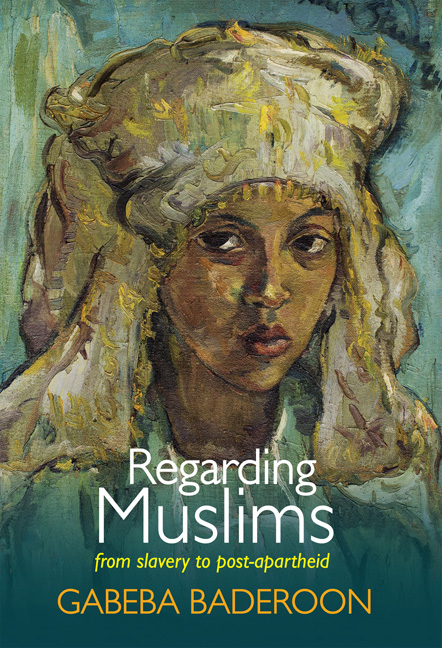Book contents
- Frontmatter
- Contents
- List of illustrations
- Acknowledgements
- Foreword
- Introduction: Beginnings in South Africa
- Chapter 1 Ambiguous Visibility: Muslims and the making of visuality
- Chapter 2 “Kitchen Language”: Muslims and the culture of food
- Chapter 3 “The Sea Inside Us”: Parallel journeys in the African oceans
- Chapter 4 “Sexual Geographies of the Cape”: Slavery, race and sexual violence
- Chapter 5 Regarding Muslims: Pagad, masked men and veiled women
- Chapter 6 “The Trees Sway North-North-East”: Post-apartheid visions of Islam
- Conclusion
- Notes
- Glossary
- Bibliography
- Index
- Plate section
Chapter 4 - “Sexual Geographies of the Cape”: Slavery, race and sexual violence
Published online by Cambridge University Press: 21 April 2018
- Frontmatter
- Contents
- List of illustrations
- Acknowledgements
- Foreword
- Introduction: Beginnings in South Africa
- Chapter 1 Ambiguous Visibility: Muslims and the making of visuality
- Chapter 2 “Kitchen Language”: Muslims and the culture of food
- Chapter 3 “The Sea Inside Us”: Parallel journeys in the African oceans
- Chapter 4 “Sexual Geographies of the Cape”: Slavery, race and sexual violence
- Chapter 5 Regarding Muslims: Pagad, masked men and veiled women
- Chapter 6 “The Trees Sway North-North-East”: Post-apartheid visions of Islam
- Conclusion
- Notes
- Glossary
- Bibliography
- Index
- Plate section
Summary
History is what hurts.
– Fredric Jameson (1981: 102)Tell me that old story, the one about
the girl in the schoolyard. The Coloured
girl who was surrounded by boys …
… Do you
remember that story? It has been
running between my legs like blood
for years.
– Yvette Christiansë, “Sunday School” (1999: 47)So I guess
the P is not for poetry.
– Reclaiming the P… Word (2006)Silence, slavery and sexual violence
What is the relationship of slavery to sexuality?
For almost two hundred years, the system of slavery ensured that systemic sexual violence was built into the colonies that would eventually form South Africa. Due to a gender imbalance in the Cape Colony, enslaved as well as free black women were a source of marriage partners for settlers throughout the slave-holding period, while the Slave Lodge, which housed VOC-owned slaves, was “Cape Town's main brothel” (Keegan 1996: 20). By 1830, domestic labour in paternalistic slave-holding households was the primary role carried out by two-thirds of enslaved people in the Cape, a system that exposed them to serial violence and sexual abuse (Mason 2003: 108). John Mason's research into the records of the Office of the Protector of Slaves revealed numerous cases of sexual abuse brought against slave-owners by slave women. Indeed, as the feminist historian Gerda Lerner points out, “for women, sexual exploitation marked the very definition of enslavement, as it did not for men” (quoted in Mason 2003: 101). Gender and sexuality were therefore crucial factors in South African slavery.
At the Cape, colonial discourses about the licentious and animalistic sexuality of colonised people normalised the violation of black women's bodies (Hendricks 2001: 37). Enslaved and Khoisan women's bodies were designated as available for sexual access with impunity. Robert Ross notes that the “authorities at the Cape did not question the right of an unmarried or widowed slave-owner to the body of his female slaves” (1983: 114). During the entire period of slavery at the Cape, not a single free or enslaved man was convicted of the rape of an enslaved woman, Ross shows. Sexual violence was therefore fundamental to colonisation at the Cape, and the scale of such violence under the founding social system of slavery in South Africa demands sustained scholarly attention.
- Type
- Chapter
- Information
- Regarding Muslimsfrom slavery to post-apartheid, pp. 83 - 106Publisher: Wits University PressPrint publication year: 2014



